University Financial Accounting Report: Sunshine Limited Case Study
VerifiedAdded on 2020/05/16
|10
|3160
|111
Report
AI Summary
This report provides a comprehensive analysis of a financial accounting case study involving Sunshine Limited. The case centers around ethical dilemmas faced by the company's accountant, Maria Mars, who was pressured by the general manager to manipulate the firm's reported profits. The report identifies violations of integrity, transparency, and objectivity within the company's financial practices. It examines the impact of changing the depreciation method, from straight-line to sum-of-years-digits, to manipulate financial statements and discusses the stakeholders involved, including customers, communities, suppliers, creditors, and shareholders. Furthermore, the report explores the influence of AASB 116 on the case, offering a detailed examination of the ethical and regulatory aspects. The report also includes a comparison of depreciation methods, and the financial implications of the actions taken by the accountant and general manager. The report highlights the ethical implications and the importance of transparent financial reporting. This report serves as an invaluable resource for students studying financial accounting and business ethics.

Running head: FINANCIAL ACCOUNTING
Financial accounting
Name of the student
Name of the university
Author note
Financial accounting
Name of the student
Name of the university
Author note
Paraphrase This Document
Need a fresh take? Get an instant paraphrase of this document with our AI Paraphraser
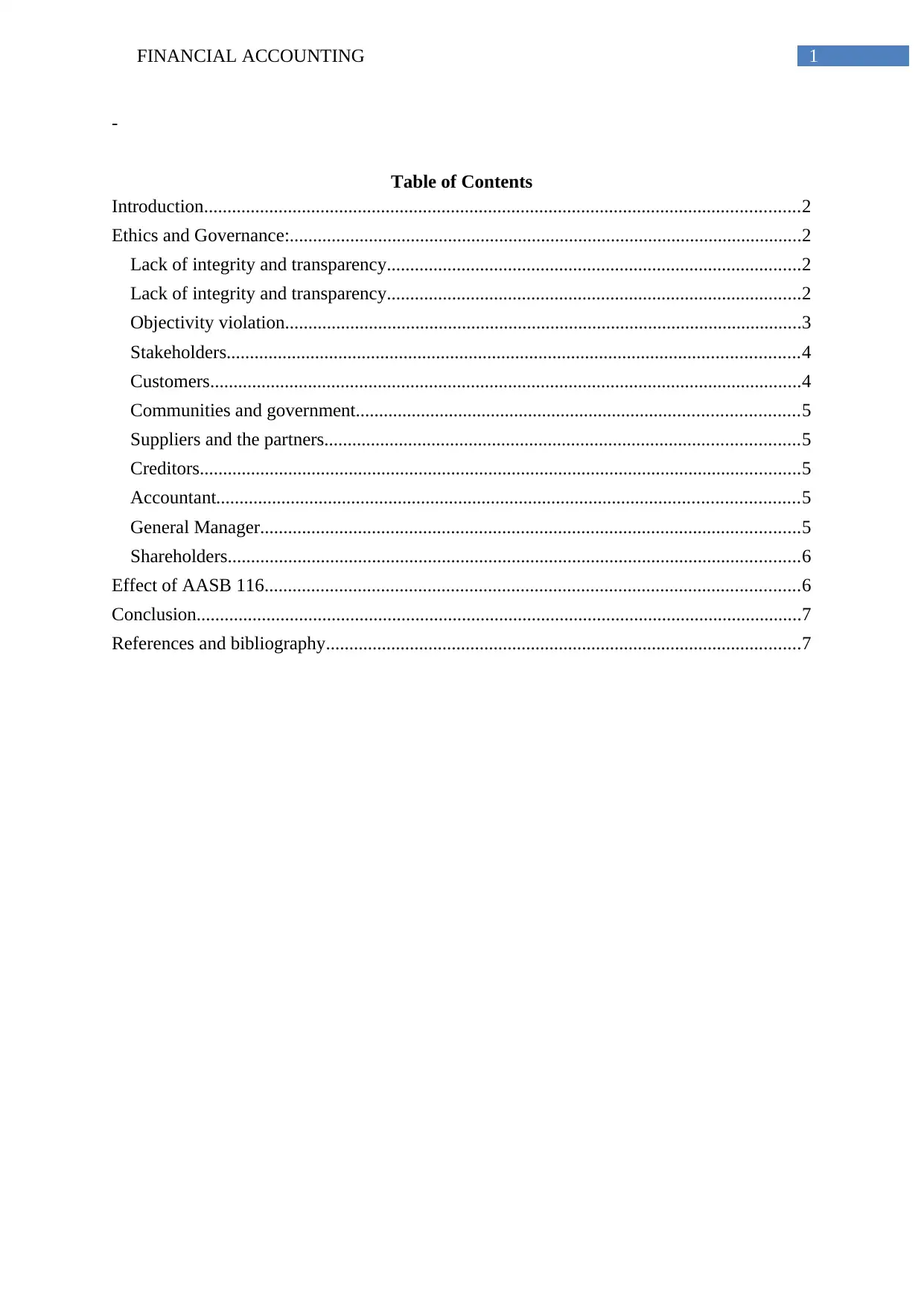
1FINANCIAL ACCOUNTING
-
Table of Contents
Introduction................................................................................................................................2
Ethics and Governance:..............................................................................................................2
Lack of integrity and transparency.........................................................................................2
Lack of integrity and transparency.........................................................................................2
Objectivity violation...............................................................................................................3
Stakeholders...........................................................................................................................4
Customers...............................................................................................................................4
Communities and government...............................................................................................5
Suppliers and the partners......................................................................................................5
Creditors.................................................................................................................................5
Accountant.............................................................................................................................5
General Manager....................................................................................................................5
Shareholders...........................................................................................................................6
Effect of AASB 116...................................................................................................................6
Conclusion..................................................................................................................................7
References and bibliography......................................................................................................7
-
Table of Contents
Introduction................................................................................................................................2
Ethics and Governance:..............................................................................................................2
Lack of integrity and transparency.........................................................................................2
Lack of integrity and transparency.........................................................................................2
Objectivity violation...............................................................................................................3
Stakeholders...........................................................................................................................4
Customers...............................................................................................................................4
Communities and government...............................................................................................5
Suppliers and the partners......................................................................................................5
Creditors.................................................................................................................................5
Accountant.............................................................................................................................5
General Manager....................................................................................................................5
Shareholders...........................................................................................................................6
Effect of AASB 116...................................................................................................................6
Conclusion..................................................................................................................................7
References and bibliography......................................................................................................7
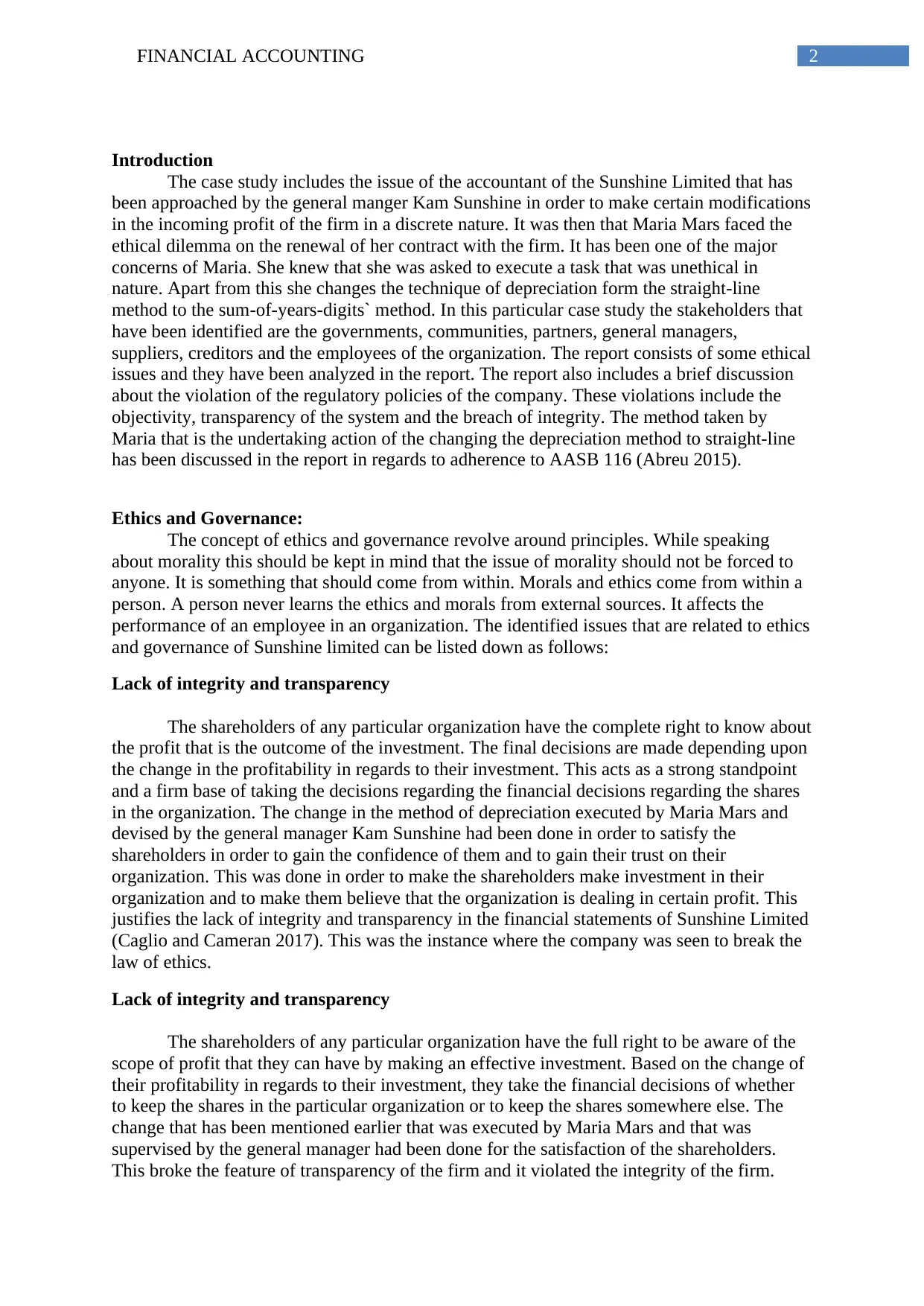
2FINANCIAL ACCOUNTING
Introduction
The case study includes the issue of the accountant of the Sunshine Limited that has
been approached by the general manger Kam Sunshine in order to make certain modifications
in the incoming profit of the firm in a discrete nature. It was then that Maria Mars faced the
ethical dilemma on the renewal of her contract with the firm. It has been one of the major
concerns of Maria. She knew that she was asked to execute a task that was unethical in
nature. Apart from this she changes the technique of depreciation form the straight-line
method to the sum-of-years-digits` method. In this particular case study the stakeholders that
have been identified are the governments, communities, partners, general managers,
suppliers, creditors and the employees of the organization. The report consists of some ethical
issues and they have been analyzed in the report. The report also includes a brief discussion
about the violation of the regulatory policies of the company. These violations include the
objectivity, transparency of the system and the breach of integrity. The method taken by
Maria that is the undertaking action of the changing the depreciation method to straight-line
has been discussed in the report in regards to adherence to AASB 116 (Abreu 2015).
Ethics and Governance:
The concept of ethics and governance revolve around principles. While speaking
about morality this should be kept in mind that the issue of morality should not be forced to
anyone. It is something that should come from within. Morals and ethics come from within a
person. A person never learns the ethics and morals from external sources. It affects the
performance of an employee in an organization. The identified issues that are related to ethics
and governance of Sunshine limited can be listed down as follows:
Lack of integrity and transparency
The shareholders of any particular organization have the complete right to know about
the profit that is the outcome of the investment. The final decisions are made depending upon
the change in the profitability in regards to their investment. This acts as a strong standpoint
and a firm base of taking the decisions regarding the financial decisions regarding the shares
in the organization. The change in the method of depreciation executed by Maria Mars and
devised by the general manager Kam Sunshine had been done in order to satisfy the
shareholders in order to gain the confidence of them and to gain their trust on their
organization. This was done in order to make the shareholders make investment in their
organization and to make them believe that the organization is dealing in certain profit. This
justifies the lack of integrity and transparency in the financial statements of Sunshine Limited
(Caglio and Cameran 2017). This was the instance where the company was seen to break the
law of ethics.
Lack of integrity and transparency
The shareholders of any particular organization have the full right to be aware of the
scope of profit that they can have by making an effective investment. Based on the change of
their profitability in regards to their investment, they take the financial decisions of whether
to keep the shares in the particular organization or to keep the shares somewhere else. The
change that has been mentioned earlier that was executed by Maria Mars and that was
supervised by the general manager had been done for the satisfaction of the shareholders.
This broke the feature of transparency of the firm and it violated the integrity of the firm.
Introduction
The case study includes the issue of the accountant of the Sunshine Limited that has
been approached by the general manger Kam Sunshine in order to make certain modifications
in the incoming profit of the firm in a discrete nature. It was then that Maria Mars faced the
ethical dilemma on the renewal of her contract with the firm. It has been one of the major
concerns of Maria. She knew that she was asked to execute a task that was unethical in
nature. Apart from this she changes the technique of depreciation form the straight-line
method to the sum-of-years-digits` method. In this particular case study the stakeholders that
have been identified are the governments, communities, partners, general managers,
suppliers, creditors and the employees of the organization. The report consists of some ethical
issues and they have been analyzed in the report. The report also includes a brief discussion
about the violation of the regulatory policies of the company. These violations include the
objectivity, transparency of the system and the breach of integrity. The method taken by
Maria that is the undertaking action of the changing the depreciation method to straight-line
has been discussed in the report in regards to adherence to AASB 116 (Abreu 2015).
Ethics and Governance:
The concept of ethics and governance revolve around principles. While speaking
about morality this should be kept in mind that the issue of morality should not be forced to
anyone. It is something that should come from within. Morals and ethics come from within a
person. A person never learns the ethics and morals from external sources. It affects the
performance of an employee in an organization. The identified issues that are related to ethics
and governance of Sunshine limited can be listed down as follows:
Lack of integrity and transparency
The shareholders of any particular organization have the complete right to know about
the profit that is the outcome of the investment. The final decisions are made depending upon
the change in the profitability in regards to their investment. This acts as a strong standpoint
and a firm base of taking the decisions regarding the financial decisions regarding the shares
in the organization. The change in the method of depreciation executed by Maria Mars and
devised by the general manager Kam Sunshine had been done in order to satisfy the
shareholders in order to gain the confidence of them and to gain their trust on their
organization. This was done in order to make the shareholders make investment in their
organization and to make them believe that the organization is dealing in certain profit. This
justifies the lack of integrity and transparency in the financial statements of Sunshine Limited
(Caglio and Cameran 2017). This was the instance where the company was seen to break the
law of ethics.
Lack of integrity and transparency
The shareholders of any particular organization have the full right to be aware of the
scope of profit that they can have by making an effective investment. Based on the change of
their profitability in regards to their investment, they take the financial decisions of whether
to keep the shares in the particular organization or to keep the shares somewhere else. The
change that has been mentioned earlier that was executed by Maria Mars and that was
supervised by the general manager had been done for the satisfaction of the shareholders.
This broke the feature of transparency of the firm and it violated the integrity of the firm.
⊘ This is a preview!⊘
Do you want full access?
Subscribe today to unlock all pages.

Trusted by 1+ million students worldwide
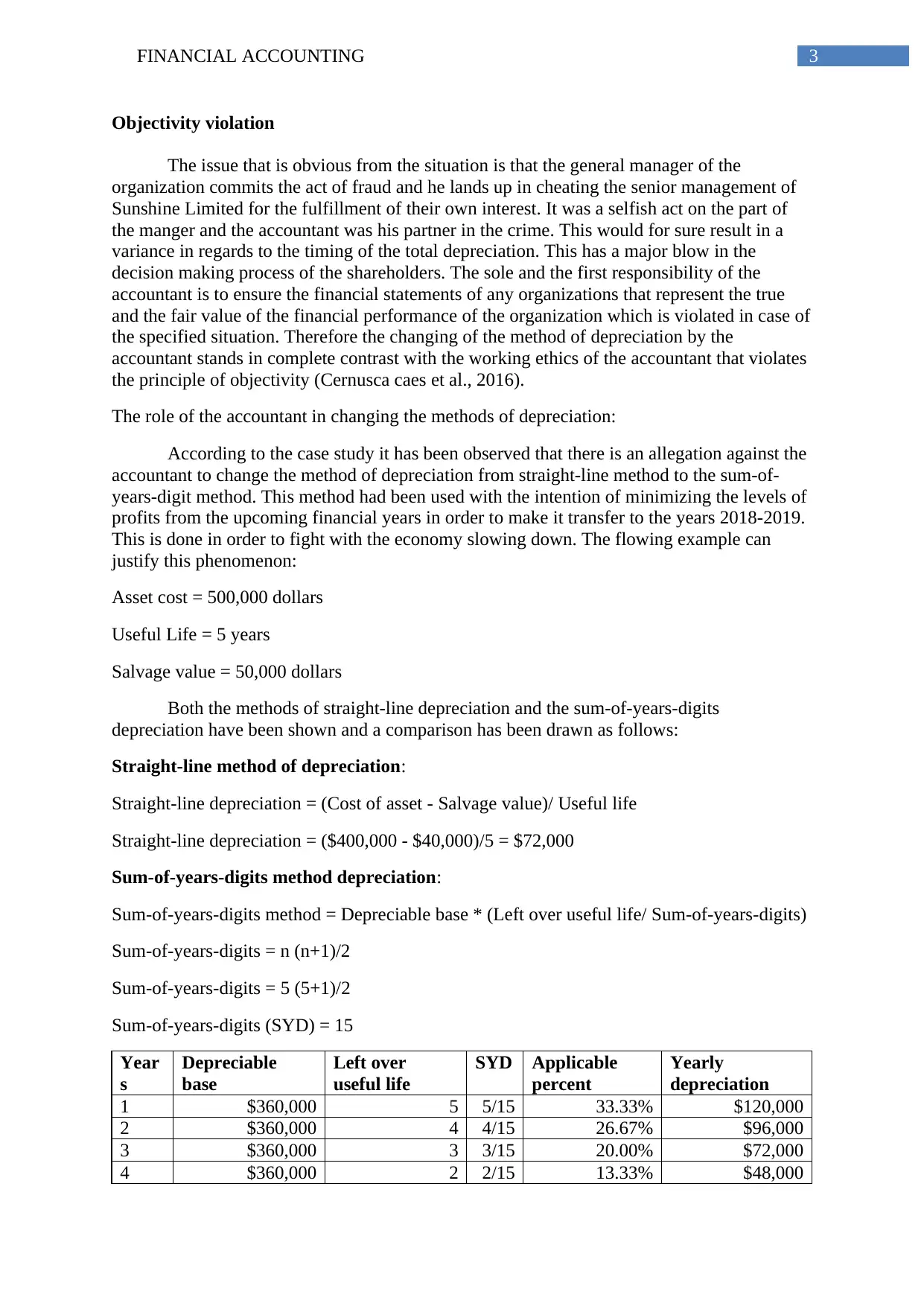
3FINANCIAL ACCOUNTING
Objectivity violation
The issue that is obvious from the situation is that the general manager of the
organization commits the act of fraud and he lands up in cheating the senior management of
Sunshine Limited for the fulfillment of their own interest. It was a selfish act on the part of
the manger and the accountant was his partner in the crime. This would for sure result in a
variance in regards to the timing of the total depreciation. This has a major blow in the
decision making process of the shareholders. The sole and the first responsibility of the
accountant is to ensure the financial statements of any organizations that represent the true
and the fair value of the financial performance of the organization which is violated in case of
the specified situation. Therefore the changing of the method of depreciation by the
accountant stands in complete contrast with the working ethics of the accountant that violates
the principle of objectivity (Cernusca caes et al., 2016).
The role of the accountant in changing the methods of depreciation:
According to the case study it has been observed that there is an allegation against the
accountant to change the method of depreciation from straight-line method to the sum-of-
years-digit method. This method had been used with the intention of minimizing the levels of
profits from the upcoming financial years in order to make it transfer to the years 2018-2019.
This is done in order to fight with the economy slowing down. The flowing example can
justify this phenomenon:
Asset cost = 500,000 dollars
Useful Life = 5 years
Salvage value = 50,000 dollars
Both the methods of straight-line depreciation and the sum-of-years-digits
depreciation have been shown and a comparison has been drawn as follows:
Straight-line method of depreciation:
Straight-line depreciation = (Cost of asset - Salvage value)/ Useful life
Straight-line depreciation = ($400,000 - $40,000)/5 = $72,000
Sum-of-years-digits method depreciation:
Sum-of-years-digits method = Depreciable base * (Left over useful life/ Sum-of-years-digits)
Sum-of-years-digits = n (n+1)/2
Sum-of-years-digits = 5 (5+1)/2
Sum-of-years-digits (SYD) = 15
Year
s
Depreciable
base
Left over
useful life
SYD Applicable
percent
Yearly
depreciation
1 $360,000 5 5/15 33.33% $120,000
2 $360,000 4 4/15 26.67% $96,000
3 $360,000 3 3/15 20.00% $72,000
4 $360,000 2 2/15 13.33% $48,000
Objectivity violation
The issue that is obvious from the situation is that the general manager of the
organization commits the act of fraud and he lands up in cheating the senior management of
Sunshine Limited for the fulfillment of their own interest. It was a selfish act on the part of
the manger and the accountant was his partner in the crime. This would for sure result in a
variance in regards to the timing of the total depreciation. This has a major blow in the
decision making process of the shareholders. The sole and the first responsibility of the
accountant is to ensure the financial statements of any organizations that represent the true
and the fair value of the financial performance of the organization which is violated in case of
the specified situation. Therefore the changing of the method of depreciation by the
accountant stands in complete contrast with the working ethics of the accountant that violates
the principle of objectivity (Cernusca caes et al., 2016).
The role of the accountant in changing the methods of depreciation:
According to the case study it has been observed that there is an allegation against the
accountant to change the method of depreciation from straight-line method to the sum-of-
years-digit method. This method had been used with the intention of minimizing the levels of
profits from the upcoming financial years in order to make it transfer to the years 2018-2019.
This is done in order to fight with the economy slowing down. The flowing example can
justify this phenomenon:
Asset cost = 500,000 dollars
Useful Life = 5 years
Salvage value = 50,000 dollars
Both the methods of straight-line depreciation and the sum-of-years-digits
depreciation have been shown and a comparison has been drawn as follows:
Straight-line method of depreciation:
Straight-line depreciation = (Cost of asset - Salvage value)/ Useful life
Straight-line depreciation = ($400,000 - $40,000)/5 = $72,000
Sum-of-years-digits method depreciation:
Sum-of-years-digits method = Depreciable base * (Left over useful life/ Sum-of-years-digits)
Sum-of-years-digits = n (n+1)/2
Sum-of-years-digits = 5 (5+1)/2
Sum-of-years-digits (SYD) = 15
Year
s
Depreciable
base
Left over
useful life
SYD Applicable
percent
Yearly
depreciation
1 $360,000 5 5/15 33.33% $120,000
2 $360,000 4 4/15 26.67% $96,000
3 $360,000 3 3/15 20.00% $72,000
4 $360,000 2 2/15 13.33% $48,000
Paraphrase This Document
Need a fresh take? Get an instant paraphrase of this document with our AI Paraphraser

4FINANCIAL ACCOUNTING
5 $360,000 1 1/15 6.67% $24,000
Statement showing variation in depreciation
Year
s
Straight-
line
depreciati
on
Yearly
depreciati
on (SYD)
Variatio
n
1 $72,000 $120,000 ($48,000
)
2 $72,000 $96,000 ($24,000
)
3 $72,000 $72,000 Nil
4 $72,000 $48,000 $22,000
5 $72,000 $24,000 $48,000
In order to increase the amount of depreciation the necessary modifications in the
method of depreciation need to be made. This is estimated that it would experience a decrease
in the later years. The total amount of profit would remain fixed in the due course of time. It
is because the depreciation charges would decline over the years. This feature has enabled the
accountant Maria Mars to change the procedure of depreciation from the straight line method
to the sum-of-years-digits method for the general manager of Sunshine limited (Ghahramani,
Soleymanpor and Fatahi 2016).
Stakeholders
The stakeholders are those people who are group or individuals or any kind of
corporate entity who shows interest in any organization or entity. The Sunshine Limited firm
has a long list of stakeholders in their company. The list of the stakeholders is listed below:
Customers
The customers are the external stakeholders in case of this particular organization.
The customers are the potential customers in case of a retailer firm. The loyalty of the
customers is a prime important thing for the organization in order to survive in the market
and to make a long-term relationship with the customers. In case of transactions that are
being carried between business to business firms the organizations itself are the clients for
that particular product that has been purchased for the commercial use. The resellers of the
trade are directly engaged with the process of selling to the wholesalers or the retailers but the
end customers. This case can also be referred as the case of potential stakeholder (Hu, Percy
and Yao 2015).
5 $360,000 1 1/15 6.67% $24,000
Statement showing variation in depreciation
Year
s
Straight-
line
depreciati
on
Yearly
depreciati
on (SYD)
Variatio
n
1 $72,000 $120,000 ($48,000
)
2 $72,000 $96,000 ($24,000
)
3 $72,000 $72,000 Nil
4 $72,000 $48,000 $22,000
5 $72,000 $24,000 $48,000
In order to increase the amount of depreciation the necessary modifications in the
method of depreciation need to be made. This is estimated that it would experience a decrease
in the later years. The total amount of profit would remain fixed in the due course of time. It
is because the depreciation charges would decline over the years. This feature has enabled the
accountant Maria Mars to change the procedure of depreciation from the straight line method
to the sum-of-years-digits method for the general manager of Sunshine limited (Ghahramani,
Soleymanpor and Fatahi 2016).
Stakeholders
The stakeholders are those people who are group or individuals or any kind of
corporate entity who shows interest in any organization or entity. The Sunshine Limited firm
has a long list of stakeholders in their company. The list of the stakeholders is listed below:
Customers
The customers are the external stakeholders in case of this particular organization.
The customers are the potential customers in case of a retailer firm. The loyalty of the
customers is a prime important thing for the organization in order to survive in the market
and to make a long-term relationship with the customers. In case of transactions that are
being carried between business to business firms the organizations itself are the clients for
that particular product that has been purchased for the commercial use. The resellers of the
trade are directly engaged with the process of selling to the wholesalers or the retailers but the
end customers. This case can also be referred as the case of potential stakeholder (Hu, Percy
and Yao 2015).

5FINANCIAL ACCOUNTING
Communities and government
Even the communities and the government are also the external stakeholders of
Sunshine Limited. An organization operates within a community enables it with the power of
influencing beyond just the potential customers. An organization should not only pay the
taxes but it must also maintain the standard of the ethics. This would ensure the sustainability
of the environment in which it operates. Apart from this the organization must also be
associated with the charitable events. The regulation that has been undertaken by the
government can drastically affect the business that has been undertaken by the organization.
It is because of this reason that the organization must maintain a respectable association with
the local officials in order to keep a track of the implementation of the new regulations or
other community developments that might affect the business (Parle, Joubert and Laing
2017).
Suppliers and the partners
The partners in the business and the suppliers are the most important stakeholders of
the business in the current scenario. A good relationship between the business partners and
the associates benefits the organization in many ways. The trade partners can benefit business
by delivering a valuable service to the end customers. The particular organization would
benefit if they maintain a good relation with the suppliers and the partners as the supply is an
important aspect of such organization (Loyeung and Matolcsy 2015).
Creditors
The creditors are those from where the business leverages finance in order to carry out
the necessary business proceedings. The banks provide loans for the major purchases like the
land and building. The existing creditors for Sunshine Limited would expect the meeting of
deadlines in regards to the payments that are to be made by the organization. The
management must understand the fact that they should meet up to the expectation of the
creditors that would benefit the business of the organization. It would increase the chance of
profit of the organization and it would create a situation of leveraging more finance in the
future (Masino 2016).
Accountant
It was mentioned in the case study that the accountant of the organization named
Maria Mars was responsible for violating the ethical standards by preparing an incorrect
financial statement and changing the amount of profit from 2016 to 2017.
General Manager
This was also mentioned in the case study about the general manager of Sunshine
Limited named Kam Sunshine. He was the general manger of the firm and his primary
motive is to improve the overall performance of the organization. He was the supervisor of
the accountant in the fault that she had committed.
Communities and government
Even the communities and the government are also the external stakeholders of
Sunshine Limited. An organization operates within a community enables it with the power of
influencing beyond just the potential customers. An organization should not only pay the
taxes but it must also maintain the standard of the ethics. This would ensure the sustainability
of the environment in which it operates. Apart from this the organization must also be
associated with the charitable events. The regulation that has been undertaken by the
government can drastically affect the business that has been undertaken by the organization.
It is because of this reason that the organization must maintain a respectable association with
the local officials in order to keep a track of the implementation of the new regulations or
other community developments that might affect the business (Parle, Joubert and Laing
2017).
Suppliers and the partners
The partners in the business and the suppliers are the most important stakeholders of
the business in the current scenario. A good relationship between the business partners and
the associates benefits the organization in many ways. The trade partners can benefit business
by delivering a valuable service to the end customers. The particular organization would
benefit if they maintain a good relation with the suppliers and the partners as the supply is an
important aspect of such organization (Loyeung and Matolcsy 2015).
Creditors
The creditors are those from where the business leverages finance in order to carry out
the necessary business proceedings. The banks provide loans for the major purchases like the
land and building. The existing creditors for Sunshine Limited would expect the meeting of
deadlines in regards to the payments that are to be made by the organization. The
management must understand the fact that they should meet up to the expectation of the
creditors that would benefit the business of the organization. It would increase the chance of
profit of the organization and it would create a situation of leveraging more finance in the
future (Masino 2016).
Accountant
It was mentioned in the case study that the accountant of the organization named
Maria Mars was responsible for violating the ethical standards by preparing an incorrect
financial statement and changing the amount of profit from 2016 to 2017.
General Manager
This was also mentioned in the case study about the general manager of Sunshine
Limited named Kam Sunshine. He was the general manger of the firm and his primary
motive is to improve the overall performance of the organization. He was the supervisor of
the accountant in the fault that she had committed.
⊘ This is a preview!⊘
Do you want full access?
Subscribe today to unlock all pages.

Trusted by 1+ million students worldwide
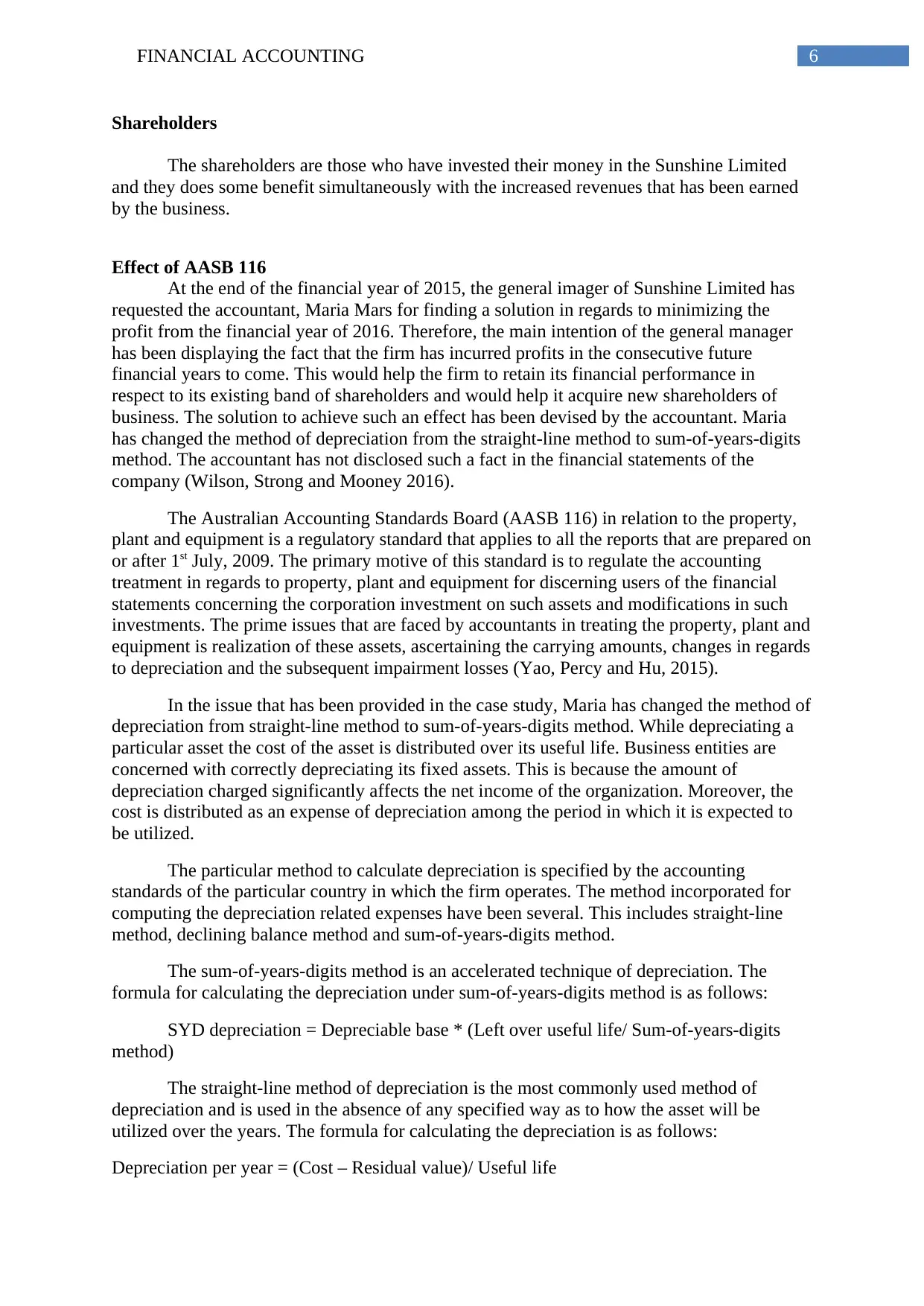
6FINANCIAL ACCOUNTING
Shareholders
The shareholders are those who have invested their money in the Sunshine Limited
and they does some benefit simultaneously with the increased revenues that has been earned
by the business.
Effect of AASB 116
At the end of the financial year of 2015, the general imager of Sunshine Limited has
requested the accountant, Maria Mars for finding a solution in regards to minimizing the
profit from the financial year of 2016. Therefore, the main intention of the general manager
has been displaying the fact that the firm has incurred profits in the consecutive future
financial years to come. This would help the firm to retain its financial performance in
respect to its existing band of shareholders and would help it acquire new shareholders of
business. The solution to achieve such an effect has been devised by the accountant. Maria
has changed the method of depreciation from the straight-line method to sum-of-years-digits
method. The accountant has not disclosed such a fact in the financial statements of the
company (Wilson, Strong and Mooney 2016).
The Australian Accounting Standards Board (AASB 116) in relation to the property,
plant and equipment is a regulatory standard that applies to all the reports that are prepared on
or after 1st July, 2009. The primary motive of this standard is to regulate the accounting
treatment in regards to property, plant and equipment for discerning users of the financial
statements concerning the corporation investment on such assets and modifications in such
investments. The prime issues that are faced by accountants in treating the property, plant and
equipment is realization of these assets, ascertaining the carrying amounts, changes in regards
to depreciation and the subsequent impairment losses (Yao, Percy and Hu, 2015).
In the issue that has been provided in the case study, Maria has changed the method of
depreciation from straight-line method to sum-of-years-digits method. While depreciating a
particular asset the cost of the asset is distributed over its useful life. Business entities are
concerned with correctly depreciating its fixed assets. This is because the amount of
depreciation charged significantly affects the net income of the organization. Moreover, the
cost is distributed as an expense of depreciation among the period in which it is expected to
be utilized.
The particular method to calculate depreciation is specified by the accounting
standards of the particular country in which the firm operates. The method incorporated for
computing the depreciation related expenses have been several. This includes straight-line
method, declining balance method and sum-of-years-digits method.
The sum-of-years-digits method is an accelerated technique of depreciation. The
formula for calculating the depreciation under sum-of-years-digits method is as follows:
SYD depreciation = Depreciable base * (Left over useful life/ Sum-of-years-digits
method)
The straight-line method of depreciation is the most commonly used method of
depreciation and is used in the absence of any specified way as to how the asset will be
utilized over the years. The formula for calculating the depreciation is as follows:
Depreciation per year = (Cost – Residual value)/ Useful life
Shareholders
The shareholders are those who have invested their money in the Sunshine Limited
and they does some benefit simultaneously with the increased revenues that has been earned
by the business.
Effect of AASB 116
At the end of the financial year of 2015, the general imager of Sunshine Limited has
requested the accountant, Maria Mars for finding a solution in regards to minimizing the
profit from the financial year of 2016. Therefore, the main intention of the general manager
has been displaying the fact that the firm has incurred profits in the consecutive future
financial years to come. This would help the firm to retain its financial performance in
respect to its existing band of shareholders and would help it acquire new shareholders of
business. The solution to achieve such an effect has been devised by the accountant. Maria
has changed the method of depreciation from the straight-line method to sum-of-years-digits
method. The accountant has not disclosed such a fact in the financial statements of the
company (Wilson, Strong and Mooney 2016).
The Australian Accounting Standards Board (AASB 116) in relation to the property,
plant and equipment is a regulatory standard that applies to all the reports that are prepared on
or after 1st July, 2009. The primary motive of this standard is to regulate the accounting
treatment in regards to property, plant and equipment for discerning users of the financial
statements concerning the corporation investment on such assets and modifications in such
investments. The prime issues that are faced by accountants in treating the property, plant and
equipment is realization of these assets, ascertaining the carrying amounts, changes in regards
to depreciation and the subsequent impairment losses (Yao, Percy and Hu, 2015).
In the issue that has been provided in the case study, Maria has changed the method of
depreciation from straight-line method to sum-of-years-digits method. While depreciating a
particular asset the cost of the asset is distributed over its useful life. Business entities are
concerned with correctly depreciating its fixed assets. This is because the amount of
depreciation charged significantly affects the net income of the organization. Moreover, the
cost is distributed as an expense of depreciation among the period in which it is expected to
be utilized.
The particular method to calculate depreciation is specified by the accounting
standards of the particular country in which the firm operates. The method incorporated for
computing the depreciation related expenses have been several. This includes straight-line
method, declining balance method and sum-of-years-digits method.
The sum-of-years-digits method is an accelerated technique of depreciation. The
formula for calculating the depreciation under sum-of-years-digits method is as follows:
SYD depreciation = Depreciable base * (Left over useful life/ Sum-of-years-digits
method)
The straight-line method of depreciation is the most commonly used method of
depreciation and is used in the absence of any specified way as to how the asset will be
utilized over the years. The formula for calculating the depreciation is as follows:
Depreciation per year = (Cost – Residual value)/ Useful life
Paraphrase This Document
Need a fresh take? Get an instant paraphrase of this document with our AI Paraphraser
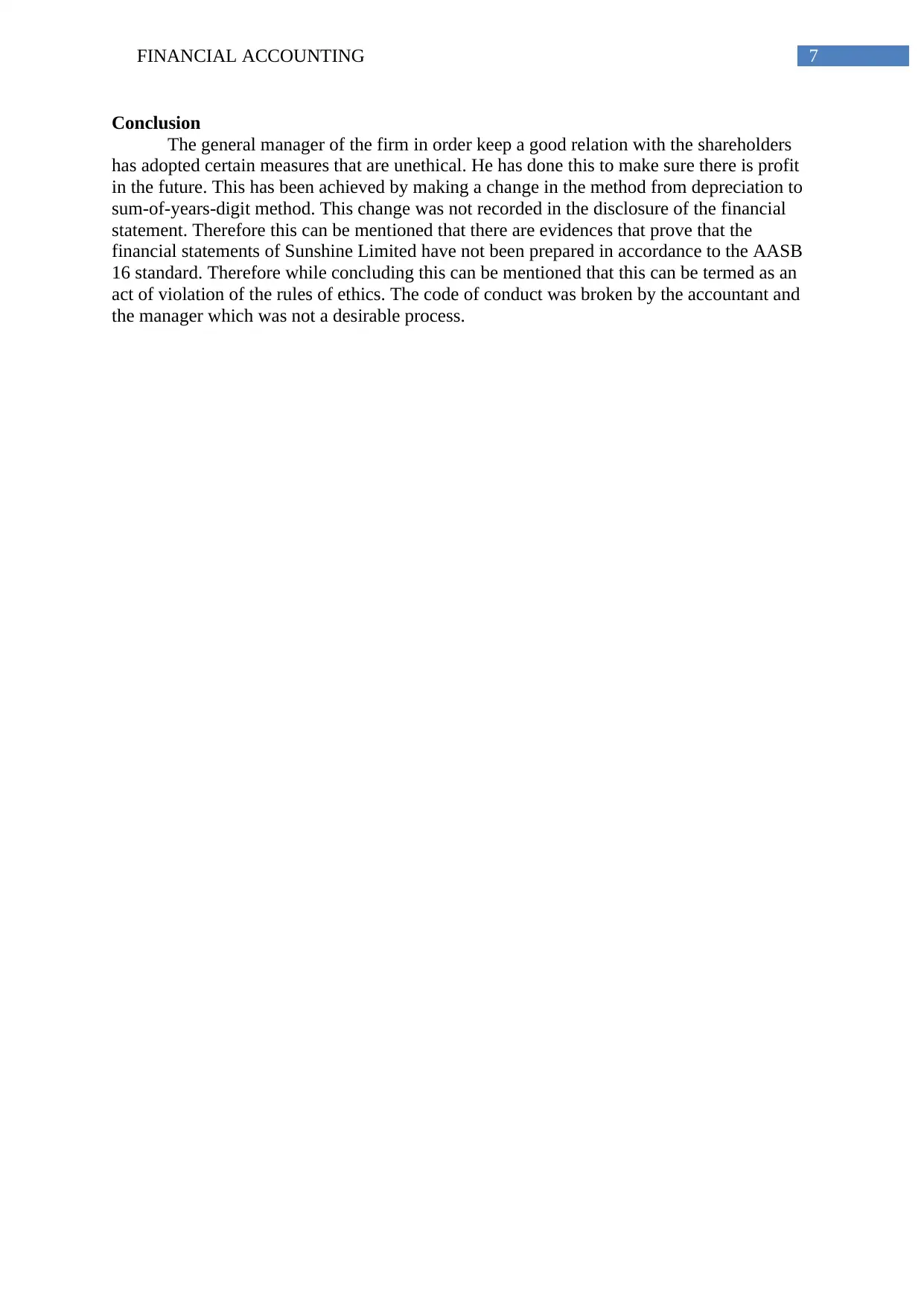
7FINANCIAL ACCOUNTING
Conclusion
The general manager of the firm in order keep a good relation with the shareholders
has adopted certain measures that are unethical. He has done this to make sure there is profit
in the future. This has been achieved by making a change in the method from depreciation to
sum-of-years-digit method. This change was not recorded in the disclosure of the financial
statement. Therefore this can be mentioned that there are evidences that prove that the
financial statements of Sunshine Limited have not been prepared in accordance to the AASB
16 standard. Therefore while concluding this can be mentioned that this can be termed as an
act of violation of the rules of ethics. The code of conduct was broken by the accountant and
the manager which was not a desirable process.
Conclusion
The general manager of the firm in order keep a good relation with the shareholders
has adopted certain measures that are unethical. He has done this to make sure there is profit
in the future. This has been achieved by making a change in the method from depreciation to
sum-of-years-digit method. This change was not recorded in the disclosure of the financial
statement. Therefore this can be mentioned that there are evidences that prove that the
financial statements of Sunshine Limited have not been prepared in accordance to the AASB
16 standard. Therefore while concluding this can be mentioned that this can be termed as an
act of violation of the rules of ethics. The code of conduct was broken by the accountant and
the manager which was not a desirable process.

8FINANCIAL ACCOUNTING
References and bibliography
Abreu, R., 2015. Accounting for Citizenship: The role of Accountant. Procedia Economics
and Finance, 26, pp.933-941.
Bansal, A., 2014. An empirical study of teaching ethics on accountancy students.
International Journal of Business and Administration Research Review, 1(3), pp.152-157.
Caglio, A. and Cameran, M., 2017. Is it Shameful to be an Accountant? GenMe Perception
(s) of Accountants' Ethics. Abacus, 53(1), pp.1-27.
Cernusca, L., David, D., Nicolaescu, C. and Gomoi, B.C., 2016. Empirical study on the
creative accounting phenomenon. Studia Universitatis „Vasile Goldis” Arad–Economics
Series, 26(2), pp.63-87.
Ghahramani, B., Soleymanpor, M. and Fatahi, R., 2016. ETHICS IN ACCOUNTING AND
AUDITING. IIOAB JOURNAL, 7, pp.293-299.
Hu, F., Percy, M. and Yao, D., 2015. Asset revaluations and earnings management: Evidence
from Australian companies. Corporate Ownership and Control, 13(1), pp.930-939.
Laing, G.K. and Perrin, R.W., 2014. Deconstructing an accounting paradigm shift: AASB
116 non-current asset measurement models. International Journal of Critical Accounting,
6(5-6), pp.509-519.
Loyeung, A. and Matolcsy, Z., 2015. CFO's accounting talent, compensation and turnover.
Accounting & Finance, 55(4), pp.1105-1134.
Masino, A., 2016. Modifying the Certified Public Accountant Application Process for
Academic Misconduct.
Parle, G., Joubert, M. and Laing, G.K., 2017. Measuring economic performance of Real
Estate Developers in Australia:(A Longitudinal Study). Journal of New Business Ideas &
Trends, 15(1).
Shawver, T.J. and Miller, W.F., 2017. Moral intensity revisited: Measuring the benefit of
accounting ethics interventions. Journal of Business Ethics, 141(3), pp.587-603.
Vorster, J., 2015. Negotiating the ethics minefield: industry insights-ethics. Professional
Accountant, 2015(25), p.23.
Walsh, J., 2014. The Role of Ethics in a Future Accounting Career.
Wilson, B., Strong, J. and Mooney, K., 2016. AN EXPLORATORY INVESTIGATION OF
EFFECTIVE ACCOUNTING ETHICS CPE. Journal of International Business Disciplines,
11(2).
Yao, D.F.T., Percy, M. and Hu, F., 2015. Fair value accounting for non-current assets and
audit fees: Evidence from Australian companies. Journal of Contemporary Accounting &
Economics, 11(1), pp.31-45.
Yao, D.F.T., Percy, M. and Hu, F., 2015. Journal of Contemporary Accounting &
Economics. Journal of Contemporary Accounting & Economics, 11, pp.31-45.
References and bibliography
Abreu, R., 2015. Accounting for Citizenship: The role of Accountant. Procedia Economics
and Finance, 26, pp.933-941.
Bansal, A., 2014. An empirical study of teaching ethics on accountancy students.
International Journal of Business and Administration Research Review, 1(3), pp.152-157.
Caglio, A. and Cameran, M., 2017. Is it Shameful to be an Accountant? GenMe Perception
(s) of Accountants' Ethics. Abacus, 53(1), pp.1-27.
Cernusca, L., David, D., Nicolaescu, C. and Gomoi, B.C., 2016. Empirical study on the
creative accounting phenomenon. Studia Universitatis „Vasile Goldis” Arad–Economics
Series, 26(2), pp.63-87.
Ghahramani, B., Soleymanpor, M. and Fatahi, R., 2016. ETHICS IN ACCOUNTING AND
AUDITING. IIOAB JOURNAL, 7, pp.293-299.
Hu, F., Percy, M. and Yao, D., 2015. Asset revaluations and earnings management: Evidence
from Australian companies. Corporate Ownership and Control, 13(1), pp.930-939.
Laing, G.K. and Perrin, R.W., 2014. Deconstructing an accounting paradigm shift: AASB
116 non-current asset measurement models. International Journal of Critical Accounting,
6(5-6), pp.509-519.
Loyeung, A. and Matolcsy, Z., 2015. CFO's accounting talent, compensation and turnover.
Accounting & Finance, 55(4), pp.1105-1134.
Masino, A., 2016. Modifying the Certified Public Accountant Application Process for
Academic Misconduct.
Parle, G., Joubert, M. and Laing, G.K., 2017. Measuring economic performance of Real
Estate Developers in Australia:(A Longitudinal Study). Journal of New Business Ideas &
Trends, 15(1).
Shawver, T.J. and Miller, W.F., 2017. Moral intensity revisited: Measuring the benefit of
accounting ethics interventions. Journal of Business Ethics, 141(3), pp.587-603.
Vorster, J., 2015. Negotiating the ethics minefield: industry insights-ethics. Professional
Accountant, 2015(25), p.23.
Walsh, J., 2014. The Role of Ethics in a Future Accounting Career.
Wilson, B., Strong, J. and Mooney, K., 2016. AN EXPLORATORY INVESTIGATION OF
EFFECTIVE ACCOUNTING ETHICS CPE. Journal of International Business Disciplines,
11(2).
Yao, D.F.T., Percy, M. and Hu, F., 2015. Fair value accounting for non-current assets and
audit fees: Evidence from Australian companies. Journal of Contemporary Accounting &
Economics, 11(1), pp.31-45.
Yao, D.F.T., Percy, M. and Hu, F., 2015. Journal of Contemporary Accounting &
Economics. Journal of Contemporary Accounting & Economics, 11, pp.31-45.
⊘ This is a preview!⊘
Do you want full access?
Subscribe today to unlock all pages.

Trusted by 1+ million students worldwide
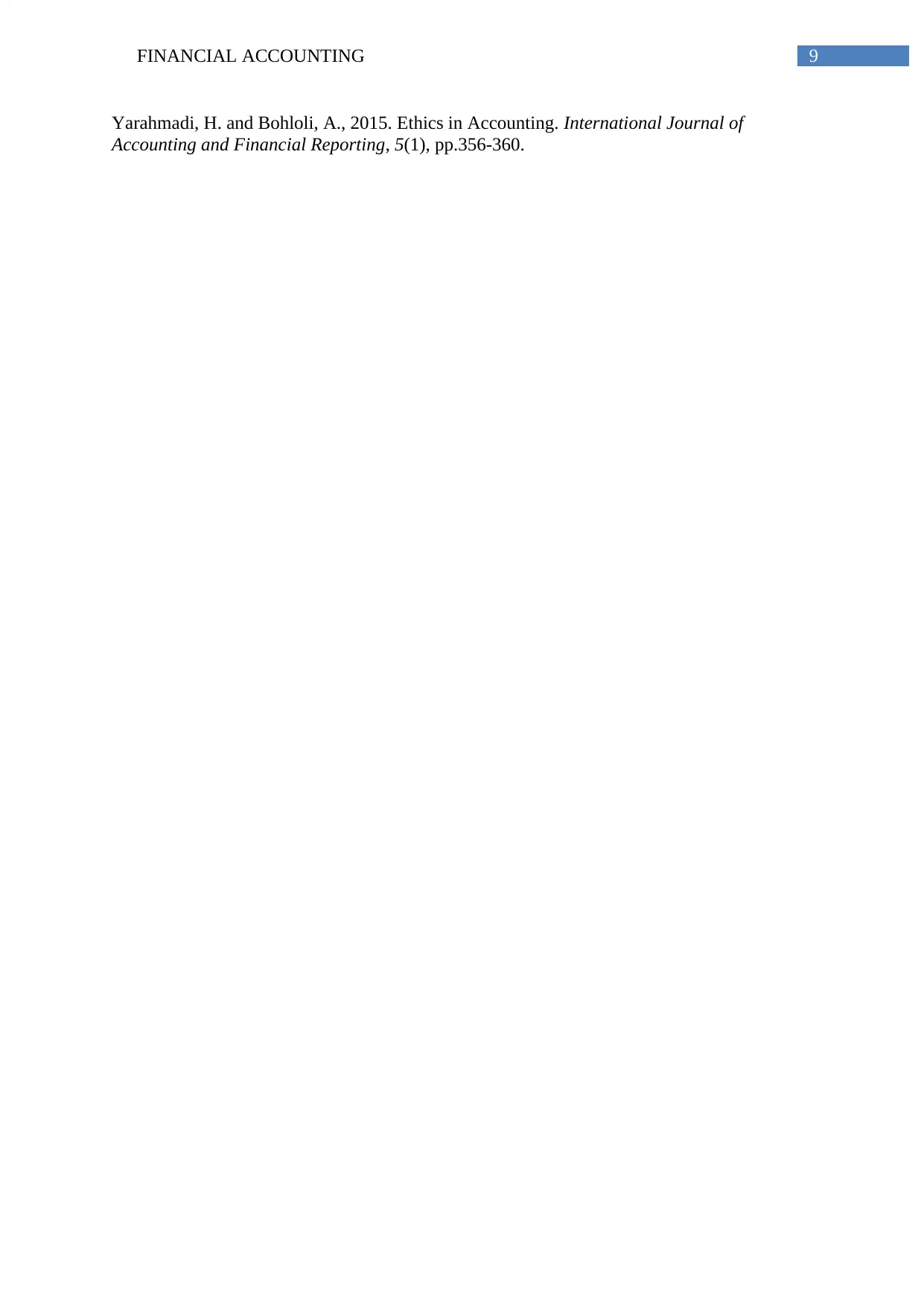
9FINANCIAL ACCOUNTING
Yarahmadi, H. and Bohloli, A., 2015. Ethics in Accounting. International Journal of
Accounting and Financial Reporting, 5(1), pp.356-360.
Yarahmadi, H. and Bohloli, A., 2015. Ethics in Accounting. International Journal of
Accounting and Financial Reporting, 5(1), pp.356-360.
1 out of 10
Related Documents
Your All-in-One AI-Powered Toolkit for Academic Success.
+13062052269
info@desklib.com
Available 24*7 on WhatsApp / Email
![[object Object]](/_next/static/media/star-bottom.7253800d.svg)
Unlock your academic potential
Copyright © 2020–2025 A2Z Services. All Rights Reserved. Developed and managed by ZUCOL.





